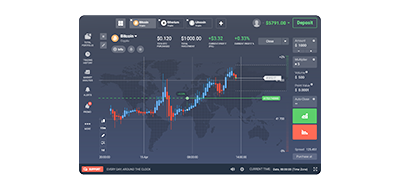Quay lại
Contents
What is a White Label Brokerage and How Does it Work?

White Label

Demetris Makrides
Senior Business Development Manager

Vitaly Makarenko
Chief Commercial Officer
In today’s fast-moving world of finance, being able to innovate and adapt is key to a business’s ability to survive and thrive. The concept of a white label brokerage has been gaining steam over the past several years for its ability to level the playing field. While this concept is hardly new, it is making a big impact in the field of finance and brokerages. Let’s consider what a white label brokerage is, how it works, and what benefits it provides.
What is a White Label Brokerage?
The term “white label” comes from the music industry. Vinyl records were sent to radio stations in plain white sleeves, devoid of branding. As time passed, this concept was later adopted all across various industries, including finance.
To put things simply, a white label product is just a licensing agreement. The brokerage basically purchases a complete product that is devoid of any branding, brands it accordingly, and then resells it as if it is its own product. For a brokerage, this means that it receives a fully working platform, then changes the appearance and the functionalities to suit the needs of its target clientele, and presents it to the market as its own trading platform.
Now that we have a better understanding of what a WL platform is, let us take a closer look and the benefits offered.
Advantages of a White Label Brokerage
The evolution and demand of WL brokerages did not happen by chance. A wide array of benefits served as a catalyst for the mass adoption of WL products.

Cost Effectiveness
Starting a brokerage from the ground up is an immense task, requiring you to juggle and balance numerous factors. These include having to deal with software issues, necessary and reliable technology, hiring skilled and trustworthy workers, as well as dealing with a maze of regulations and laws depending on the country. All these factors put a tremendous strain on the business owner’s wallet, leading to bloated entry costs. As a result, many prospective entrants are deterred by the prohibitive costs. The white label platform considerably eases the financial burden when starting a brokerage. The great thing is you only pay for what you need: the firm is able to get a product that is perfectly suited for its current scale and future trajectory. Thus, firms are able to hundreds of thousand of dollars during the crucial beginning stages.
Quick Market Entry
For brokerages in the world of finance, time is a lot more than just money– it is opportunity. Any delay in establishing your presence and a brokerage doesn’t just lose money; it loses ground on the competition. Utilizing a white label brokerage, with its fully functional platform, allows potential business owners to enter the market quickly. And instead of wasting time and money on the initial launch stages, firms can direct those funds to marketing and client acquisition.
Brand Customization
The fact that the white label product comes as a general platform is another tangible benefit for the brokerage. This allows the brokerage to turn the product into its own. Developing an intuitive, user-friendly interface, integrating trading tools specific to the clientele, additional various education resources, and adding the company logo and colors – all this is in the hands of the brokerage. With such extensive customization options, brokerages are able to stand out from the competition and cultivate customer loyalty even in a saturated market.
Continuous Support
The technology in the financial sector is always evolving and improving. While this is a necessary and positive thing, it does present a set of challenges to brokerage owners. Firms must constantly adjust to changing regulations, new and improved software options, new security threats, new trading tools, and the list goes on. This places a heavy burden on the brokerage as a large workforce is needed to stay on top of all developments. Those opting for a WL solution have a safety net in the face of the provider’s dedicated support teams. The objective of these support teams is to ensure the platform is always updated and compliant with regulatory requirements. They also ensure security and protection, which is vital in finance.
Scalability
Business growth is a necessary and crucial part of a company’s natural evolution. This includes expansion, diversification, and sometimes even consolidation or downgrading. The benefit of using a WL platform is that it was designed with this in mind and can seamlessly handle the stress of scalability. As the brokerage grows and deals with increased clientele, trading volume, and asset classes, the WL platform is equipped to handle the necessary changes without major downtime. This means that funds do not have to be dedicated to long updates or infrastructure overhauls. The WL product is able to grow and evolve along with the firm’s individual needs, simplifying the natural growth process.
Despite the numerous benefits that the WL provider offers, brokerages need to consider some of the potential challenges. These are discussed below.
Potential Challenges
While the temptation is to focus solely on the benefits and advantages the WL product offers, it is necessary to take a holistic view of the product. Thus, the challenges must also be openly discussed.
Dependency Risk
For all the features and functionalities the WL solution provides, the brokerage is never the actual owner of the platform. Thus, a third party is always present, meaning that even when customized to your needs, the external provider remains the owner. Should that third party encounter problems, this will directly affect your brokerage. Things such as unexpected downtimes, glitches, and maintenance could all have serious ramifications for your brokerage. A brokerage can find itself dealing with problems and customer concerns that it has no control over.
You may also like

Limited Differentiation
The WL product can be customized according to the brokerage’s needs, but it is important to remember that the options are not unlimited. At some point, the limitations will become obvious. How can a brokerage stand out in a crowded market when many of the competitors are using the same platform provider, with just brand customization being the distinctive factor?
Cost Structure
One of the main benefits of a WL product can also be a double-edged sword. As discussed above, the WL solution provides an excellent and cost-effective way to launch a brokerage. However, as the brokerage expands and the operations grow intricate, the pricing structure may not be as tolerable for the brokerage as it used to be. This can include an increase in transactional costs, charges for additional features and functionalities, or added security.
Integration Concerns
A brokerage is not just transaction and trades, but it is a living ecosystem that relies or a number of tools and platforms to thrive. Going beyond simply the transaction part of the brokerage, a CRM system, dashboard, analytics, and reports – all play a role in ensuring the platform’s survival and growth. Thus, integration of other tools must be seamless and quick. Any difficulties can disrupt the operational flow, leading to problems. As this is all part of the client-facing side, everything must be running smoothly and effortlessly. Otherwise, losing clients will become a real problem.
Now that some of the major benefits and challenges have been discussed let’s explore how a firm can begin working with a white label provider.
Partnering with a White Label Provider
Selecting a WL provider certainly eases the process of starting your own brokerages. However, planning is still needed in order for the process to go smoothly. Let’s explore some of the necessary steps.
Partnering with a Provider
Your first important decision to make is selecting a provider. As this will be a strategic alliance for years to come, many things must be considered. Look at more than simply the cost of the product, but consider the value your brokerage will be getting in return. Also, make sure to research the reputation and the track record of the provider and look for things such as system uptime, various support teams, and compliance updates. Research customer reviews and testimonials so you can get a first-hand look at what you will be getting. Many find that providers with robust technologies and 24/7 support teams are the more crucial aspects of a WL solution.
Customizing the Platform
The next step is the exciting customization process, where you will mold and create a platform to reflect your brand and your unique identity. In addition to the cosmetic changes, you will customize the user interface and trading tools. This process will need both your design team and the provider’s technical team to ensure a smooth and seamless integration.
Regulation and Compliance
Depending on your country of choice, you will need to deal with a number of regulatory bodies, numerous laws, and endless regulations. A single misstep can have disastrous consequences, from fines to a total shutdown. Working closely with the legal teams ensures you can avoid such disasters and remain fully functional. This means ensuring you have the needed licenses to operate a brokerage in the current jurisdiction.
Marketing and Client Acquisition
Now that the platform is customized, compliant with all regulations, and ready for exploitation, the goal is to drive as much traffic as possible to the platform. Effective marketing is the key to acquiring a large customer base. However, there is no “one correct way” to market. Effective marketing includes digital marketing campaigns, various partnerships, publications, and education channels. Having a clear picture of your target audience will help you design the most effective marketing campaign for your brokerage.
Operation and Maintenance
One of the biggest factors in building a solid and trustworthy reputation for a brokerage is its operational efficiency. This means that your platform is able to handle the various operation aspects, such as trade executions, risk management, and customer service: ensure your support teams are available and well-trained to do just that. Periodically review and stress-test your platform in order to spot and eliminate any bugs or deficiencies. If you have selected a good provider, often their support teams will be able to assist you with such tasks, as well.
Having a plan is not enough; the success of a white label brokerage depends on execution and adherence to industry best practices, which we will explore in the following section.
You may also like

Best Practices
Let’s talk about some best practices for organizations looking to make their mark in the white label brokerage industry.

Conduct Market Research
In order to be successful, you must first understand the landscape in which your brokerage will be operating. Thus, market research is vital before actually diving in and launching the brokerage. This includes studying potential competitors, researching the demographic and psychographic makeup of the targeted clientele, and identifying and recognizing the gaps in the market and the best ways to fill them. Furthermore, comprehensive market research allows you to find specific pain points, as well as the customer wishes and desires in a platform, and then address these specific needs, giving you a competitive edge.
Ensure Security Measures
In the current digital age, where so much personal information is stored online, a data breach or a cyberattack is an absolute disaster. As the WL brokerage will have the customer’s personal sensitive information, as well as handling large financial transactions, security must be a top priority. Ensure that the brokerage will employ multi-factor authentication, the latest and most advanced encryption techniques, and conduct frequent security audits. Caring for security also includes the client’s side: by educating clients about best security practices will enhance and fortify the overall security infrastructure.
Cultivate Strong Provider Partnerships
As discussed above, a WL platform is not a stand-alone project but part of an ecosystem. It is vital to develop good working relationships with a multitude of partners. An important aspect is developing and maintaining open lines of communication in order to ensure that any issues, problems, developments, or updates are addressed immediately. As the relationship is for the benefit of all parties, it is in everyone’s best interests that the platform runs well. Regularly communicating and organizing check-ins and feedback sessions can help everyone succeed.
Continuous Monitoring
Due to the constant evolution of the world of finance, as well as the speed at which new technologies are being developed, it is vital to continue to improve and get better and not rest on one’s laurels. Continuous monitoring of the platform’s performance is necessary to achieve optimal results. Also, actively seeking feedback from customers can be of great help when trying to improve the platform. Listening to the client’s feedback and taking into account their wishes when updating and integrating new functionalities will lead to increased customer satisfaction and customer loyalty, as well as help the brokerage stay efficient and ahead of the competition.
Conclusion
The white label model has changed the landscape of the financial world. Through its quick market entry without the exorbitant startup costs and difficulties of building a bespoke platform from scratch, a WL solution allows for more opportunities to launch a brokerage. As the markets continue to evolve, utilizing the WL product to its fullest will be key for those wanting to succeed and stay on top.
Đã cập nhật:
19 tháng 12, 2024
12 tháng 3, 2025
NEW POST FOR TESTING BLOG AND WP
What is Lorem Ipsum? test link with http Lorem Ipsum is simply dummy text of the printing and typesetting industry. Lorem Ipsum has been the industry’s standard dummy text ever since the 1500s, when an unknown printer took a galley of type and scrambled it to make a type specimen book. It has survived not only […]



